Butterflies have a life cycle consisting of 4 stages: egg, larva (caterpillar), pupa (chrysalis) and adult.
EGG
Table of Contents
The egg generally is about the size of a pinhead. The eggs can be found either on the underside or top of its’ host plants leaf. As the egg matures, which takes between 3-5 days, it will darken and you can see the caterpillar inside.
The caterpillar will start moving inside the egg and chew its’ way out of the egg. It will continue to eat part of the empty egg shell. This provides nutrients for the newly hatched larva until it moves onto the host leaf where it will start to feed.
Larva (caterpillar)
The larva will continue to feed on its host plants leaves for approximately 10 days. During this time it will shed it skin 5 times. As the larva grows its’ skin becomes too small and it dries out and the larva simply crawls out of it.
At the end of this stage, the larva will spin a button of silk with its’ mouth. When the larva is finished it will crawl directly over it. At this point, it will shoot its’ cremaster into the button of silk. Once it is secure the larva will let go of the branch and drop down into the “J” position.
“J” Position – The “J” position is the last small stage before the larva goes into it pupa. It is during this short stage that the larva will split its’ skin and quickly start twisting and turning until it ends up in its pupa (chrysalis).
Pupa (Chrysalis)
Once in the pupa stage, it will take approximately another 10 days for the butterfly to develop and emerge as an adult butterfly.
Adult Butterfly
Once the butterfly has hatched from its’ pupa it will cling to the pupa shell. It will start to pump up its’ wings with the fluid that is now in its abdomen. This only takes a short time. Once the wings are fully extended the butterfly’s wings will take about an hour to dry.
After that is done, the butterfly will be able to fly. It will take approximately 1-3 days until the butterfly will be able to mate and then the cycle will continue on. In most cases, it takes approximately 30 days from the time the egg has been laid until a butterfly hatches.
This whole process is called Metamorphosis.
Life Cycle Of The Painted Lady Butterfly
The metamorphosis of the Painted Lady Butterfly takes approximately 30 days.
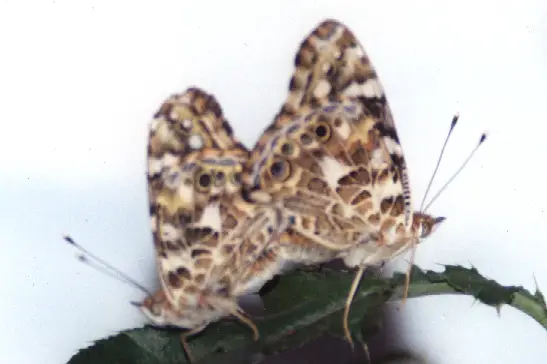
Newly hatch Painted Lady Larva (Caterpillars)
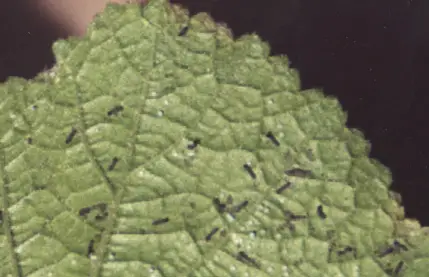
Painted Lady Larva (Caterpillar)
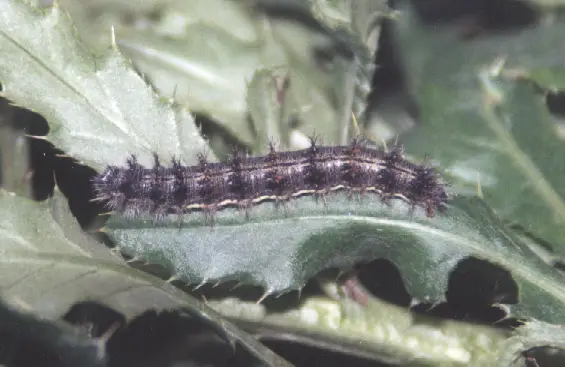
Painted Lady Larva in “J” formation
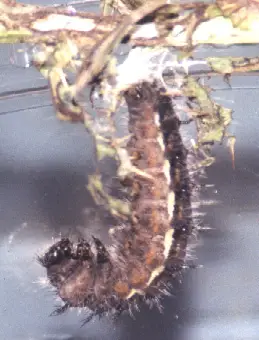
Painted Lady Pupa (Chrysalis)

Adult Painted Lady Butterfly
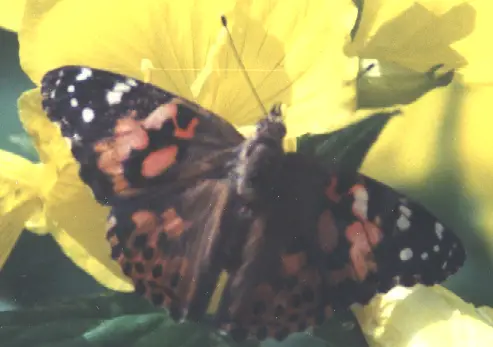
What’s the Difference Between a Moth and a Butterfly?
The first step in using these two resources to identify a specimen is to decide whether you are dealing with a moth or a butterfly.
Adults
Most adult butterflies are diurnal (active during the day) and brightly colored. Their bodies are generally slender and not especially pubescent (hairy). In contrast, adult moths are generally nocturnal (active at night) or crepuscular (active at dawn or dusk). Although some, such as the Io moth are brightly colored or have colorful “eyespots,” most moths are drab, with cryptic wing patterns. Bodies tend to be bulky and are often quite pubescent.
If you can get a good look at them, the shape of the antennae is the best way to distinguish butterflies from moths. Except for one group of tropical butterflies, all butterflies have simple antennae that end in swelling or “club.” The clubs may be very pronounced, as in the Nokomis Fritillary or more subtle, as in the White-dotted Cattleheart. Moth antennae range in shape from simple, as in the Rustic sphinx, to feather-like, as in the male White-streaked saturnia moth, but all of them lack the clubbed tip.
Caterpillars and Pupae
Unfortunately, there are no simple characteristics that universally distinguish moth caterpillars or pupae from those of butterflies. Two resources that may help if you are trying to identify a caterpillar are Caterpillars of Eastern Forests and Caterpillars of Pacific Northwest Forests and Woodlands. These cover a broad range of butterfly and moth caterpillars, and together with larval photos in Butterflies of North America and Moths of North America may allow you to identify your specimen or at least narrow it to family. We do not have any guides for pupa identification.
How Long Do Butterflies And Moths Live?
A complete answer to this seemingly simple question is more complex than you might expect, as life span varies among species. Within a species, it may also depend upon latitude, time of year, and even local weather conditions.
Adult Life Span: If you are thinking only in terms of the winged adult stage, the answer is simpler. Marking studies suggest that adults of many (and perhaps most) species live only a week or two and that the male tends to live a few days less than the female. However, in some species, the adult life span of some generations may be much longer. For example, in some species, adults that emerge in late summer or early fall hibernate overwinter in a sheltered spot. Also, fall-hatched monarch butterflies migrate south in fall and northward in spring. Adults of these species may survive for 8-9 months or longer.
Total Life Span: Total life span includes time spent in the larval and pupal stages, as well as the adult stage. Butterflies of North America and Moths of North America list the number of annual “flights” for many species. A “flight” is a generation of adults. Thus, if a species has “two flights from May through September” it means that one generation will emerge from the pupal stage in spring and a second in summer. Actual months of emergence depend on latitude. Life spans of these two generations will be very different depending upon the species’ strategy for getting through the winter.
If the spring flight comes from eggs that were laid in fall by the previous year’s summer flight, the total life span for the spring flight is 10-11 months. Eggs laid in May/June by those adults develop much more rapidly, due to higher temperatures, and adults emerge in about 2-3 months, resulting in a total life span of 3.5 – 4 months for the summer flight, or less than half that of the spring flight. However, if the species is one in which adults of the summer flight overwinter, then the spring flight develops from eggs laid in spring, and in this case, the summer flight is the longer-lived generation.
Not all species have two flights per year. Some species, particularly northern ones, have only a single flight annually, or a total life span of about a year. Some Arctic butterflies are believed to have a 2-year life cycle due to the extremely short growing season and the scarcity of high-quality food for the larval stage. And some desert species, which normally have a life cycle of only one year, may hibernate as larvae or pupae for up to 7 years waiting for adequate rainfall to ensure the growth of the host plant. On the other hand, southern species may have numerous fast-developing but short-lived generations each year. Finally, among the many species that are distributed over a wide latitudinal zone, it is not uncommon for northern populations to have one or two flights annually while more southerly populations have many flights annually. In some cases, the number of flights is considered taxonomically significant; for example, the Eastern and Canadian tiger swallowtails are now recognized as separate species, partially based on the fact that the Canadian species has only one flight per year vs 2-3 for the Eastern species
Average Life Span: Often people want to know the “average” life span of a butterfly or some other species. This is a very different question than the one answered above, as it requires knowledge of age-specific death rates. These are not known for free-ranging Lepidoptera (or indeed for most wild animals). About all that can be said is that only a minute fraction of larvae survive to adulthood, and the average butterfly life span or life expectancy is correspondingly much shorter than the figures are given above would indicate.
How Can I Raise Butterflies Indoors for Release?
Many butterfly and moth species can easily be reared in captivity with little investment in equipment. Wide-mouth gallon jars and 1- or 2- gallon aquarium bowls make good rearing chambers. Keep the containers in a warm spot, but out of direct sunlight to prevent overheating, and cover the mouth of the container with a piece of cloth to prevent condensation.
Species with simple life history requirements are the easiest to rear. Monarch butterflies, for example, complete the entire life cycle on milkweed, and their eggs develop into adults in a single season, so overwintering is not a concern. All that is needed to rear them is a container, a supply of fresh milkweed for food, and the commitment to supply fresh food every day or two. If you have a choice of caterpillars, take the largest you can find, as it will pupate (enter the chrysalis stage) sooner than a small one. Place a stick in the jar to give the caterpillar a place to pupate. After the caterpillar pupates, arrange things in the holding jar to give the emerging adult room to fully inflate its wings. Free the adult shortly after emergence so that it can complete its life cycle.
Species such as the Eastern Tiger Swallowtail are a bit more difficult. Although these pupate on the host plant, the last “flight” (generation of adults) of the year produces offspring that overwinter as pupae. For such species, you need to determine whether you are dealing with a caterpillar that will complete its life cycle this season or one that will need to overwinter. If it is not an overwintering generation, treat it the same as you would a Monarch. If it is an overwintering generation, the pupa should be kept at ambient outdoor temperature to prevent the emergence of the adult before conditions are right for its survival. Once it cools off in fall, an unheated garage or garden shed is a good place to hold hibernating pupae.
In other species, such as the clouded sulfur, it is the caterpillar, rather than the pupal stage, that hibernates. Because larval hibernation is commonly regulated by changes in day length, species that overwinter as caterpillars are best reared outside, away from artificial light, to ensure that the larvae enter and break hibernation at the right time. Overwintering caterpillars of some species may need special substrates or quarters for hibernation. One method is to bury a large, unglazed clay flower pot three-fourths of the way into the ground in a shaded area. Plug the hole in the bottom of the pot, and place the hibernating caterpillars inside in individual open containers covered with cheesecloth. Cover the top of the flowerpot with a clay “saucer” from a larger pot and water the lid and protruding portion of the pot periodically during dry weather. Return the caterpillars to clear containers when the host plant becomes available in spring.
Another level of complexity develops with species such as the sphingid moths, which pupate underground or in the leaf litter. For these species, provide 3-4 inches of soil, topped with dry leaves, in the bottom of the rearing container. Lightly dampen the leaves periodically to maintain proper moisture levels. In severe climates, you may need to use an underground wintering chamber, such as described above, to moderate temperature and moisture extremes.
The Unexpected
Don’t be surprised if the chrysalis or cocoon you have so carefully nurtured finally opens to reveal…a wasp! Larval lepidopterans are prey for a number of parasitic wasp species that inject their eggs into caterpillars. The larval wasp devours the caterpillar from within and completes its development after the caterpillar has entered the pupal stage. Caterpillars are also parasitized by certain diptera (flies). Eggs laid on the caterpillar develop into larvae that burrow into the caterpillar and eventually kill it. The fly larvae emerge from the dead or dying caterpillar or pupa, pupate, and develop into adult flies within a short period. As grotesque as such parasitism may seem, it is all part of nature, and the parasites should be released to complete their own life cycles.
When Will My Cocoon Hatch?
A number of people have expressed disappointment that Moths of North America and Butterflies of North America do not contain information on the duration of the pupal (cocoon or chrysalis) stages of the various species.
Actually, the information that you need to approximate the emergence (“hatch”) date is there for many species if you know how to read it. The secret is in the Flights section of the species account.
A “flight” is a generation of adults. If there is only one flight, say in May-June, it means that adults emerge in May-June (usually earlier in the south, later in the north), mate, and deposit eggs. Depending upon the species, the caterpillars may complete their development in the fall, overwinter as pupae, and emerge in May-June. Or they may overwinter as caterpillars, resume development in early spring, then have a brief pupal stage and emerge as adults in May-June. The Life History section of the species account indicates the overwintering stage for many species.
If there are two well-spaced flights annually, say April-May and July-August, it means that the adults that emerge in spring lay eggs that complete the entire life cycle by July-August, and that the July-August flight produces the overwintering generation. Note that many widely distributed species have only a single flight in the north but two more in the south.
Therefore, by knowing your location within the species’ distribution, and when your caterpillar pupated relative to the species’ annual flight pattern, you can determine approximately when emergence will occur. However, because temperature (and in some species, day length) affect development rate, timing may be disrupted by indoor rearing.
